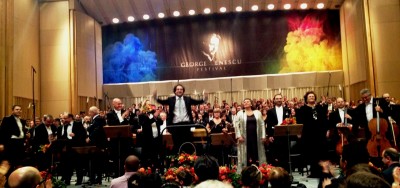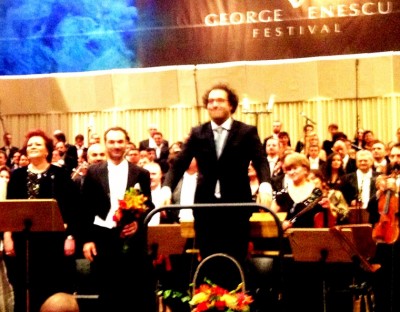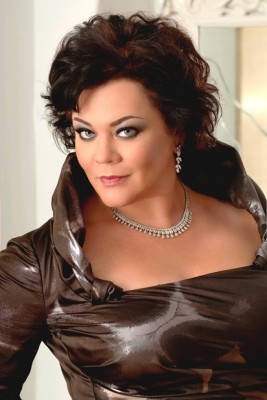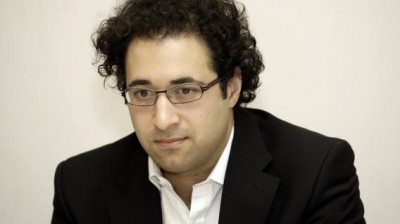Leo Hussain – succes with Gurre Lieder in Bucharest

Applaus for Gurre Lieder in Bucharest, conductor Leo Hussain surrounded by members of George Enescu Philharmonic Orchestra and soloists, from right Violeta Uramana (Tove), Nikolai Schukoff (WAldemar), Janina Baechle (Waldtabe), Leo Hussain, Thomas Johannes Meyer (Peasant and the Narator). Photo: Henning Høholt, copyright
BUCHAREST: Leo Hussains leading of Arnold Schønbergs Gurre Lieder, (composed 1900-1911), at the Enescu Festival in Bucharest with a star cast, gave him a big succes, that he really deserves.
–
Text and photos by Henning Høholt
–
The advertised conductor (Bertrand de Billy) stepped of at the first rehersal, but very sporty Leo Hussain stepped in and during three days rehersals he managed. It is his first Gurre Lieder, but I am shure that after this success he will get more requests for this demanding piece. After the concert it was ovations for the whole staff.
The cast was as Tove: Violeta Urmana, Waldemar: Nikolai Schukoff, Peasant: Thomas Johannes Mayer, Who also very sporty learned the Narators musically speaking part and performed that in addition, very good, – while the text was read in Romanian language of the actor: Victor Rebengiuc. Waldtaube was Janina Baechle. Klaus: John Daszak.
–
Gurre-Lieder is a massive cantata for five vocal soloists, narrator, chorus and large orchestra, composed by Arnold Schönberg, on poems by the Danish novelist Jens Peter Jacobsen (translated from Danish to German by Robert Franz Arnold).
–
The title means ‘Songs of Gurre‘, referring to Gurre Castle, Gurre Castle was a royal castle in North Zealand in Denmark which lies on the outskirts of Helsingør towards the town of Tikøb on the lake at Gurre in Denmark
. Scene of the medieval love-tragedy (related in Jacobsen’s poems) revolving around the Danish national legend of the love of the Danish king Valdemar Atterdag (Valdemar IV, 1320-1375, spelt Waldemar by Schönberg) for his mistress Tove, (Little Tove) and her subsequent murder by Valdemar’s jealous Queen Helvig (a legend which is historically more likely connected with his ancestor Valdemar I).
–
In 1900, Schönberg began composing the work, The cantata is divided into three parts. Whereas the first two parts,written in a lush, late-romantic style heavily influenced by Richard Wagner), are scored for solo voices and orchestra only, Later that year, he radically expanded his original conception, composing links between the first nine songs as well as adding a prelude, the Wood Dove’s Song,and the whole of Parts Two and Three.

From left Violeta Urmana, Nikolai Schukoff and Leo Hussain, applaus for Gurre Lieder, Bucharest. Foto: Henning Høholt
–
After a long break Schönberg returned to the piece in 1910, – at that time he had already written his first acknowledged atonal works.
–
The third part
, (inspired by Gustav Mahlers influence), introduces a further two soloists, a narrator, three four-part male choruses as well as a full mixed chorus. whose influence may be discernible in the orchestration of the latter parts of the Gurre-Lieder.
–
Whereas Parts One and Two are clearly Wagnerian in conception and execution, Part Three features the pared-down orchestral textures and kaleidoscopic shifts between small groups of instruments favoured by Mahler in his later symphonies. In Des Sommerwindes wilde Jagd, Schönberg also introduced the first use of Sprechgesang (or Sprechstimme), here in Bucharest, very well taken care of by Thomas Johannes Meyer – for the first time.
–
In the first part of the work, the love of Waldemar for Tove and the theme of misfortune and impending death are recounted in nine songs for soprano and tenor with orchestral accompaniment. A long orchestral interlude leads to the Wood Dove’s Song which tells of Tove’s death and Waldemar’s grief.
–
The brief second part consists of just one song in which the bereft and distraught Waldemar accuses God of cruelty. In the third part, Waldemar calls his dead vassals from their graves. The undead’s restless roaming and savage hunt around the castle at night is thunderously depicted by the male chorus, until the horde, driven by the radiance of the sunrise, recedes back into death’s sleep. During this, a peasant sings of his fear of the eerie army and there is a humorous interlude in the grotesque song of the fool Klaus who is forced to ride with the macabre host when he would rather rest in his grave. A gentle orchestral interlude depicting the light of dawn leads into the melodrama The Summer Wind’s Wild Hunt, a narration about the morning wind, which flows into the mixed-choral conclusion Seht die Sonne!(“See the Sun!”).
The large orchestra sounded great. With pleasure I noticed some deliciouse soloparts from 1. violin and 1. cello, and in addition in the wooden blowers and the brass. Furthermore good details in all the corners of the orchestra. The choire has done a good preparation work through the leadership of Iosif Ion Prunner.
Violeta Urmana as Tove is perfect, she has the voice, the power to rase on top of the orchestra, she is the right vocal type, it was extraordinary. Nikolai Schukoff has the power and the beauty, he could be even more ruf, as he is the king Valdemar in the role. Thomas Johannes Meyer is a hit, first as the Peasant, and then he even took care of the narrator Sprechgesang, which was not planned before during the rehersals, magnifique. Lately we have enjoyed him as Wotan at Opera Bastille in Paris.
Please also read about Leo Hussain in Brussels at: http://www.kulturkompasset.com/2010/11/good-requiem-by-cherubini-in-brussell/


